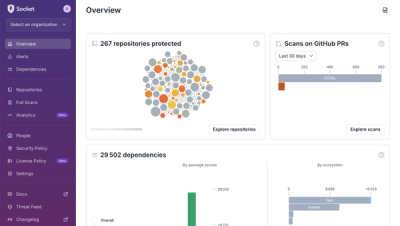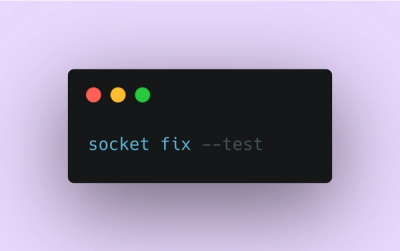
Research
Using Trusted Protocols Against You: Gmail as a C2 Mechanism
Socket uncovers malicious packages on PyPI using Gmail's SMTP protocol for command and control (C2) to exfiltrate data and execute commands.
Do stuff with Mappings and more
This library provides utility functions for manipulating and transforming data structures which have or include Mapping-like characteristics. Including inverting dictionaries, converting class like objects to dictionaries, creating nested defaultdicts, and unwrapping complex objects.
| Package |





|
| Code |




|
| Tools |




|
| CI/CD |
|
| Scans |

|
The MappingTools library is organized into several namespaces, each containing specific functionalities for
manipulating and transforming data structures. Below is a brief description of the main namespaces within the library:
collectorsThis namespace contains classes and functions for collecting and categorizing data items into mappings.
CategoryCounter: Extends a dictionary to count occurrences of data items categorized by multiple categories.MappingCollector: Collects key-value pairs into an internal mapping based on different modes (ALL, COUNT,
DISTINCT, FIRST, LAST).nested_defaultdict: Creates a nested defaultdict with specified depth and factory.operatorsThis namespace provides functions that perform operations on mappings.
distinct: Yields distinct values for a specified key across multiple mappings.keep: Yields subsets of mappings by retaining only the specified keys.remove: Yields mappings with specified keys removed.inverse: Swaps keys and values in a dictionary.flattened: Converts a nested mapping structure into a single-level dictionary by flattening the keys into
tuples.stream: Generates items from a mapping, optionally applying a factory function to each key-value pair.stream_dict_records: Generates dictionary records from a mapping with customizable key and value names.transformersThis namespace includes functions that reshape objects while maintaining the consistency of their structure.
listify: Transforms complex objects into a list of dictionaries with key and value pairs.simplify: Converts objects to strictly structured dictionaries.strictify: Applies a strict structural conversion to an object using optional converters for keys and values.stringify: Converts an object into a string representation by recursively processing it based on its type.Collectors are classes that collect data items into a Mapping.
CategoryCounterThe CategoryCounter class extends a dictionary to count occurrences of data items categorized by multiple categories. It maintains a total count of all data items and allows categorization using direct values or functions.
from mappingtools.collectors import CategoryCounter
counter = CategoryCounter()
for fruit in ['apple', 'banana', 'apple']:
counter.update({fruit: 1}, type='fruit', char_count=len(fruit), unique_char_count=len(set(fruit)))
print(counter.total)
# Output: Counter({'apple': 2, 'banana': 1})
print(counter)
# output: CategoryCounter({'type': defaultdict(<class 'collections.Counter'>, {'fruit': Counter({'apple': 2, 'banana': 1})}), 'char_count': defaultdict(<class 'collections.Counter'>, {5: Counter({'apple': 2}), 6: Counter({'banana': 1})}), 'unique_char_count': defaultdict(<class 'collections.Counter'>, {4: Counter({'apple': 2}), 3: Counter({'banana': 1})})})
MappingCollectorA class designed to collect key-value pairs into an internal mapping based on different modes. It supports modes like ALL, COUNT, DISTINCT, FIRST, and LAST, each dictating how key-value pairs are collected.
from mappingtools.collectors import MappingCollector, MappingCollectorMode
collector = MappingCollector(MappingCollectorMode.ALL)
collector.add('a', 1)
collector.add('a', 2)
collector.collect([('b', 3), ('b', 4)])
print(collector.mapping)
# output: {'a': [1, 2], 'b': [3, 4]}
nested_defaultdictCreates a nested defaultdict with specified depth and factory.
from mappingtools.collectors import nested_defaultdict
nested_dd = nested_defaultdict(1, list)
nested_dd[0][1].append('value')
print(nested_dd)
# output: defaultdict(<function nested_defaultdict.<locals>.factory at ...>, {0: defaultdict(<function nested_defaultdict.<locals>.factory at ...>, {1: ['value']})})
OperatorsOperators are functions that perform operations on Mappings.
distinctYields distinct values for a specified key across multiple mappings.
from mappingtools.operators import distinct
mappings = [
{'a': 1, 'b': 2},
{'a': 2, 'b': 3},
{'a': 1, 'b': 4}
]
distinct_values = list(distinct('a', *mappings))
print(distinct_values)
# output: [1, 2]
keepYields subsets of mappings by retaining only the specified keys.
from mappingtools.operators import keep
mappings = [
{'a': 1, 'b': 2, 'c': 3},
{'a': 4, 'b': 5, 'd': 6}
]
keys_to_keep = ['a', 'b']
output = list(keep(keys_to_keep, *mappings))
print(output)
# output: [{'a': 1, 'b': 2}, {'a': 4, 'b': 5}]
removeYields mappings with specified keys removed. It takes an iterable of keys and multiple mappings, and returns a generator of mappings with those keys excluded.
from mappingtools.operators import remove
mappings = [
{'a': 1, 'b': 2, 'c': 3},
{'a': 4, 'b': 5, 'd': 6}
]
keys_to_remove = ['a', 'b']
output = list(remove(keys_to_remove, *mappings))
print(output)
# output: [{'c': 3}, {'d': 6}]
inverseSwaps keys and values in a dictionary.
from mappingtools.operators import inverse
original_mapping = {'a': {1, 2}, 'b': {3}}
inverted_mapping = inverse(original_mapping)
print(inverted_mapping)
# output: defaultdict(<class 'set'>, {1: {'a'}, 2: {'a'}, 3: {'b'}})
flattenedThe flattened function takes a nested mapping structure and converts it into a single-level dictionary by flattening the keys into tuples.
from mappingtools.operators import flattened
nested_dict = {
'a': {'b': 1, 'c': {'d': 2}},
'e': 3
}
flat_dict = flattened(nested_dict)
print(flat_dict)
# output: {('a', 'b'): 1, ('a', 'c', 'd'): 2, ('e',): 3}
streamTakes a mapping and an optional item factory function, and generates items from the mapping. If the item factory is provided, it applies the factory to each key-value pair before yielding.
from collections import namedtuple
from mappingtools.operators import stream
def custom_factory(key, value):
return f"{key}: {value}"
my_mapping = {'a': 1, 'b': 2, 'c': 3}
for item in stream(my_mapping, custom_factory):
print(item)
# output:
# a: 1
# b: 2
# c: 3
MyTuple = namedtuple('MyTuple', ['key', 'value'])
data = {'a': 1, 'b': 2}
for item in stream(data, MyTuple):
print(item)
# output:
# MyTuple(key='a', value=1)
# MyTuple(key='b', value=2)
def record(k, v):
return {'key': k, 'value': v}
for item in stream(data, record):
print(item)
# output:
# {'key': 'a', 'value': 1}
# {'key': 'b', 'value': 2}
stream_dict_recordsgenerates dictionary records from a given mapping, where each record contains a key-value pair from the mapping with customizable key and value names.
from mappingtools.operators import stream_dict_records
mapping = {'a': 1, 'b': 2}
records = stream_dict_records(mapping, key_name='letter', value_name='number')
for record in records:
print(record)
# output:
# {'letter': 'a', 'number': 1}
# {'letter': 'b', 'number': 2}
unique_stringThe unique_strings function generates an endless stream of the shortest possible strings using a specified alphabet. By default, it uses the uppercase English alphabet (string.ascii_uppercase). The function can generate strings of a fixed length or start with the shortest strings and increase the length indefinitely.
from mappingtools.operators import unique_strings
alphabet1 = 'AB'
string_length = 3
generator1 = unique_strings(alphabet1, string_length)
for s in list(generator1):
print(s)
print('---------------')
# Example 2: Generate strings of increasing length
alphabet2 = '01'
generator2 = unique_strings(alphabet2)
for _ in range(10):
print(next(generator2))
TransformersTransformers are functions that reshape an object, while maintaining the consistency of the structure.
listifyTransforms complex objects into a list of dictionaries with key and value pairs.
from mappingtools.transformers import listify
wrapped_data = {'key1': {'subkey': 'value'}, 'key2': ['item1', 'item2']}
unwrapped_data = listify(wrapped_data)
print(unwrapped_data)
# output: [{'key': 'key1', 'value': [{'key': 'subkey', 'value': 'value'}]}, {'key': 'key2', 'value': ['item1', 'item2']}]
minifyThe minify function is designed to shorten the keys of an object using a specified alphabet. This function can be particularly useful for reducing the size of data structures, making them more efficient for storage or transmission.
from mappingtools.transformers import minify
data = [
{
'first_name': 'John',
'last_name': 'Doe',
'age': 30,
'address': {
'street': '123 Main St',
'city': 'New York',
'state': 'CA'
}
},
{
'first_name': 'Jane',
'last_name': 'Smith',
'age': 25,
'address': {
'street': '456 Rodeo Dr',
'city': 'Los Angeles',
'state': 'CA'
}
}
]
# Minify the dictionary keys
minified_dict = minify(data)
print(minified_dict)
# [{'A': 'John', 'B': 'Doe', 'C': 30, 'D': {'E': '123 Main St', 'F': 'New York', 'G': 'CA'}}, {'A': 'Jane', 'B': 'Smith', 'C': 25, 'D': {'E': '456 Rodeo Dr', 'F': 'Los Angeles', 'G': 'CA'}}]
simplifyConverts objects to strictly structured dictionaries.
from collections import Counter
from dataclasses import dataclass
from datetime import datetime
from typing import Mapping
from mappingtools.transformers import simplify
data = {'key1': 'value1', 'key2': ['item1', 'item2']}
simplified_data = simplify(data)
print(simplified_data)
# Output: {'key1': 'value1', 'key2': ['item1', 'item2']}
counter = Counter({'a': 1, 'b': 2})
print(counter)
# Output: Counter({'b': 2, 'a': 1})
simplified_counter = simplify(counter)
print(simplified_counter)
# output: {'a': 1, 'b': 2}
@dataclass
class SampleDataClass:
a: int
b: int
aa: str
bb: str
c: list[int]
d: Mapping
e: datetime
sample_datetime = datetime(2024, 7, 22, 21, 42, 17, 314159)
sample_dataclass = SampleDataClass(1, 2, '11', '22', [1, 2], {'aaa': 111, 'bbb': '222'}, sample_datetime)
print(sample_dataclass)
# output: SampleDataClass(a=1, b=2, aa='11', bb='22', c=[1, 2], d={'aaa': 111, 'bbb': '222'}, e=datetime.datetime(2024, 7, 22, 21, 42, 17, 314159))
simplified_sample_dataclass = simplify(sample_dataclass)
print(simplified_sample_dataclass)
# output: {'a': 1, 'aa': '11', 'b': 2, 'bb': '22', 'c': [1, 2], 'd': {'aaa': 111, 'bbb': '222'}, 'e': datetime.datetime(2024, 7, 22, 21, 42, 17, 314159)}
strictifyApplies a strict structural conversion to an object using optional converters for keys and values.
from mappingtools.transformers import strictify
def uppercase_key(key):
return key.upper()
def double_value(value):
return value * 2
data = {'a': 1, 'b': 2}
result = strictify(data, key_converter=uppercase_key, value_converter=double_value)
print(result)
# output: {'A': 2, 'B': 4}
stringifyConverts an object into a string representation by recursively processing it based on its type.
from mappingtools.transformers import stringify
data = {'key1': 'value1', 'key2': 'value2'}
result = stringify(data)
print(result)
# output: "key1=value1, key2=value2"
data = [1, 2, 3]
result = stringify(data)
print(result)
# output: "[1, 2, 3]"
ruff check src
ruff check tests
python -m pytest tests -n auto --cov=src --cov-branch --doctest-modules --cov-report=xml
python -m pytest tests -n auto --cov=src --cov-branch --doctest-modules --cov-report=html
FAQs
MappingTools. Do stuff with Mappings and more
We found that mappingtools demonstrated a healthy version release cadence and project activity because the last version was released less than a year ago. It has 1 open source maintainer collaborating on the project.
Did you know?

Socket for GitHub automatically highlights issues in each pull request and monitors the health of all your open source dependencies. Discover the contents of your packages and block harmful activity before you install or update your dependencies.

Research
Socket uncovers malicious packages on PyPI using Gmail's SMTP protocol for command and control (C2) to exfiltrate data and execute commands.

Product
We redesigned Socket's first logged-in page to display rich and insightful visualizations about your repositories protected against supply chain threats.

Product
Automatically fix and test dependency updates with socket fix—a new CLI tool that turns CVE alerts into safe, automated upgrades.